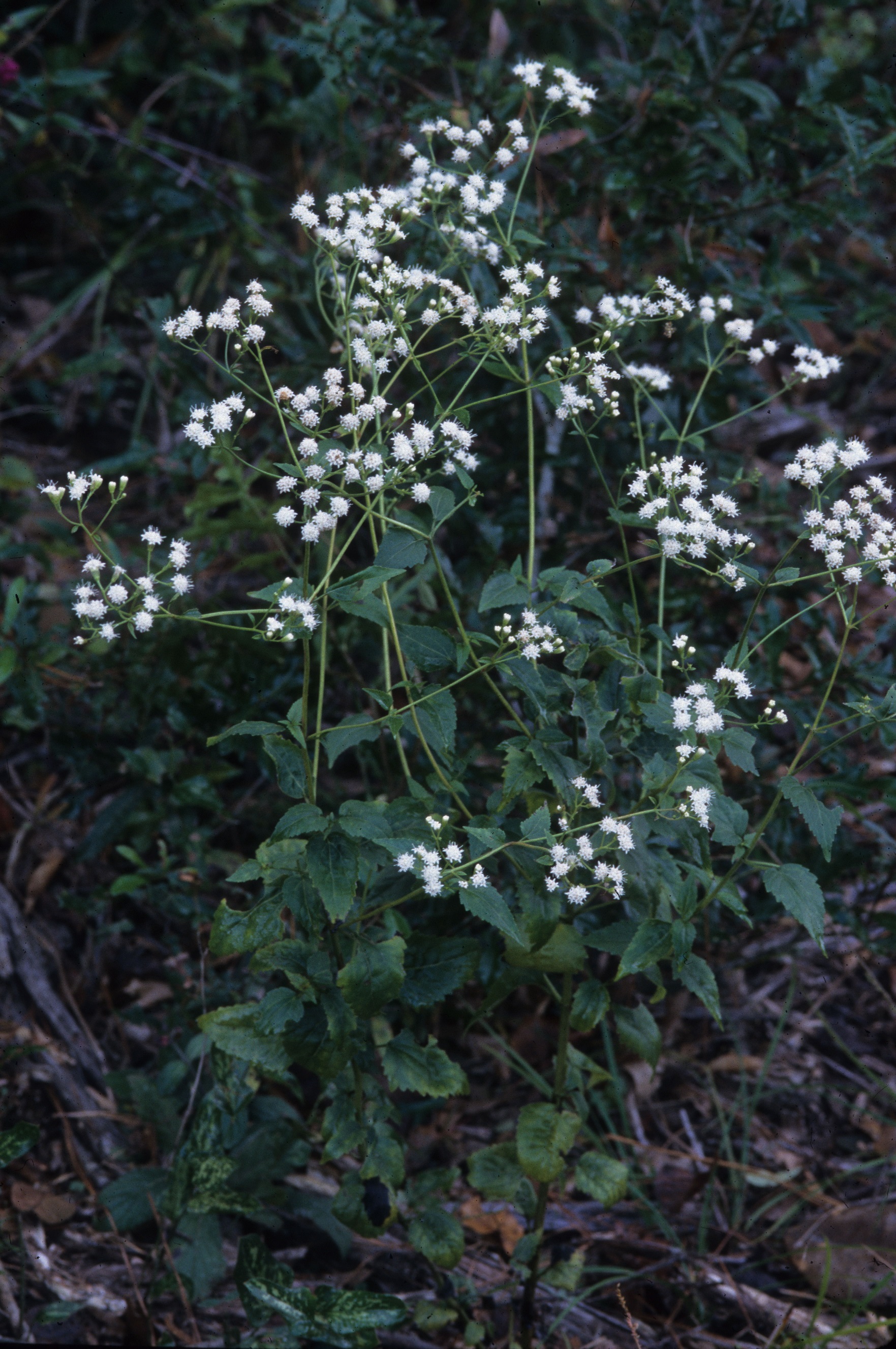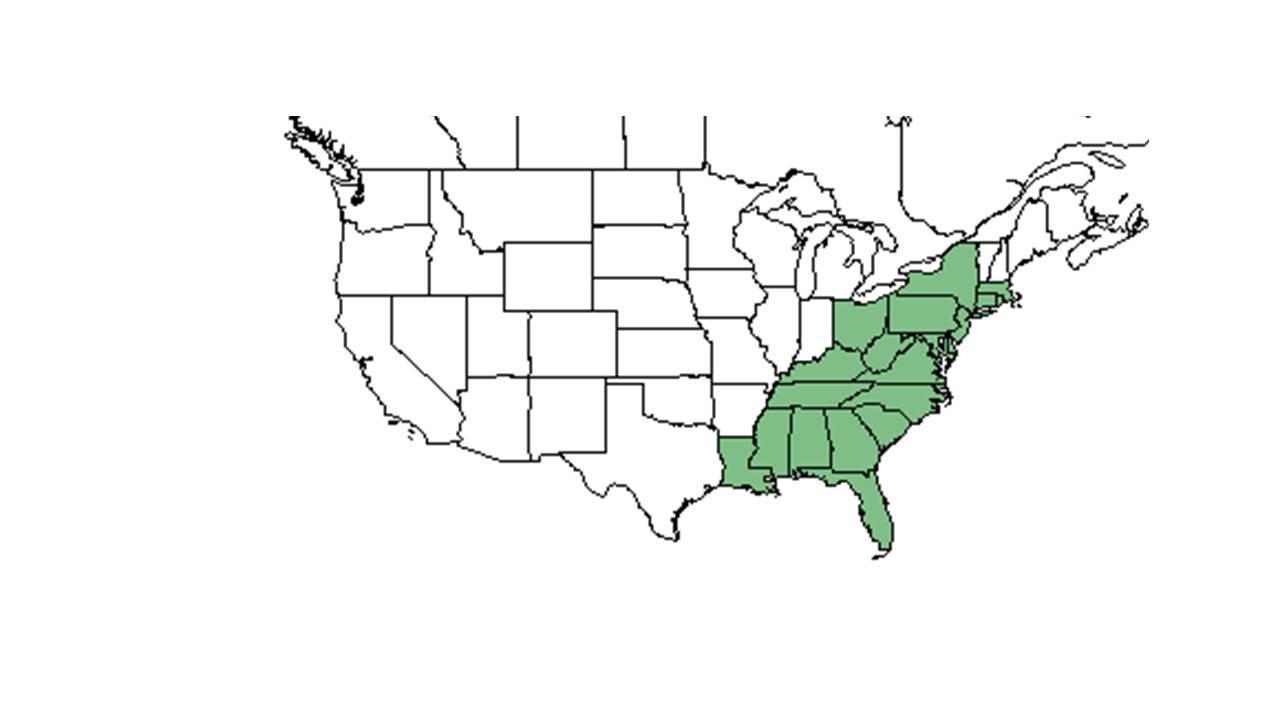Difference between revisions of "Ageratina aromatica"
KatieMccoy (talk | contribs) (→Distribution) |
KatieMccoy (talk | contribs) |
||
| Line 32: | Line 32: | ||
==Ecology== | ==Ecology== | ||
===Habitat===<!--Natural communities, human disturbed habitats, topography, hydrology, soils, light, fire regime requirements for removal of competition, etc.--> | ===Habitat===<!--Natural communities, human disturbed habitats, topography, hydrology, soils, light, fire regime requirements for removal of competition, etc.--> | ||
| − | + | In addition, it grows in longleaf pine-wiregrass flatwoods and open longleaf pine-scrub-oak-wiregrass savannas, mixed pine-hardwood forests, open oak woods, live oak woodlands, longleaf pine sand ridges, upland woodlands, and rolling red hills. ''Ageratina aromatica'' can also be found in disturbed habitat such as roadsides, along fences, and on the edges of fields. This species is observed in a range of light conditions, from open forest situations to semi-shaded and shady areas. It occurs most frequently in moist sandy loam, dry sand, and areas of lime rock <ref name="fsu".Florida State University Robert K. Godfrey Herbarium database. URL: http://herbarium.bio.fsu.edu. Last accessed: June 2014. Collectors: Loran C. Anderson, Robert Blaisdell, Andre F. Clewell, William B. Fox, J. P. Gillespie, Robert K. Godfrey, C. Jackson, Gary R. Knight, R. Komarek, Robert Kral, Robert L. Lazor, Sidney McDaniel, Richard S. Mitchell, P. L. Redfearn Jr., V. I. Sullivan, Jean W. Wooten, and Geo. Wilder MacClendons. States and Counties: Florida: Bay, Calhoun, Escambia, Franklin, Gadsden, Gulf, Holmes, Jackson, Jefferson, Leon, Levy, Liberty, Madison, Okaloosa, Putnam, Santa Rosa, St. Johns, and Wakulla. Georgia: Grady.</ref>. . | |
Associated species: ''Andropogon, Chamaecrista fasiculata, Eupatorium album, Helianthus angustifolius, Liatris graminifolia, Solidago odora, Sorghastrum nutans, Quercus'' species, ''Pinus palutris, Aristida stricta, Quercus laevis, Pinus echinata, Liatris, Dicerandra,'' and others (FSU Herbarium). | Associated species: ''Andropogon, Chamaecrista fasiculata, Eupatorium album, Helianthus angustifolius, Liatris graminifolia, Solidago odora, Sorghastrum nutans, Quercus'' species, ''Pinus palutris, Aristida stricta, Quercus laevis, Pinus echinata, Liatris, Dicerandra,'' and others (FSU Herbarium). | ||
Revision as of 17:02, 22 March 2016
| Ageratina aromatica | |
|---|---|

| |
| Photo taken by Gil Nelson | |
| Scientific classification | |
| Kingdom: | Plantae |
| Division: | Magnoliophyta - Flowering plants |
| Class: | Magnoliopsida - Dicotyledons |
| Order: | Asterales |
| Family: | Asteraceae ⁄ Compositae |
| Genus: | Ageratina |
| Species: | A. aromatica |
| Binomial name | |
| Ageratina aromatica (L.) Spach | |

| |
| Natural range of Ageratina aromatica from USDA NRCS Plants Database. | |
Common names: Lesser snakeroot; Wild hoarhound
Contents
[hide]Taxonomic notes
Synonym: Eupatorium aromaticum Linnaeus; Eupatorium aromaticum var. aromaticum; Eupatorium aromaticum var. incisum A. Gray; A. aromatica var. aromatica; A. aromatica var. incisa (Gray) C.F. Reed; Eupatorium latidens Small; Eupatorium aromaticum Linnaeus
Description
A description of Ageratina aromatica is provided in The Flora of North America.
Ageratina aromatica is a perennial[1].
Distribution
It is infrequent in west Florida. It is found west to Mississippi, east towards Pennsylvania and Massachusetts[1].
Ecology
Habitat
In addition, it grows in longleaf pine-wiregrass flatwoods and open longleaf pine-scrub-oak-wiregrass savannas, mixed pine-hardwood forests, open oak woods, live oak woodlands, longleaf pine sand ridges, upland woodlands, and rolling red hills. Ageratina aromatica can also be found in disturbed habitat such as roadsides, along fences, and on the edges of fields. This species is observed in a range of light conditions, from open forest situations to semi-shaded and shady areas. It occurs most frequently in moist sandy loam, dry sand, and areas of lime rock <ref name="fsu".Florida State University Robert K. Godfrey Herbarium database. URL: http://herbarium.bio.fsu.edu. Last accessed: June 2014. Collectors: Loran C. Anderson, Robert Blaisdell, Andre F. Clewell, William B. Fox, J. P. Gillespie, Robert K. Godfrey, C. Jackson, Gary R. Knight, R. Komarek, Robert Kral, Robert L. Lazor, Sidney McDaniel, Richard S. Mitchell, P. L. Redfearn Jr., V. I. Sullivan, Jean W. Wooten, and Geo. Wilder MacClendons. States and Counties: Florida: Bay, Calhoun, Escambia, Franklin, Gadsden, Gulf, Holmes, Jackson, Jefferson, Leon, Levy, Liberty, Madison, Okaloosa, Putnam, Santa Rosa, St. Johns, and Wakulla. Georgia: Grady.</ref>. .
Associated species: Andropogon, Chamaecrista fasiculata, Eupatorium album, Helianthus angustifolius, Liatris graminifolia, Solidago odora, Sorghastrum nutans, Quercus species, Pinus palutris, Aristida stricta, Quercus laevis, Pinus echinata, Liatris, Dicerandra, and others (FSU Herbarium).
Phenology
This species flowers in the fall (Wunderlin and Hansen 2003). It has been observed flowering and fruiting in October and November in particular (FSU Herbarium).
Conservation and Management
Cultivation and restoration
Photo Gallery
References and notes
Florida State University Robert K. Godfrey Herbarium database. URL: http://herbarium.bio.fsu.edu. Last accessed: June 2014. Collectors: Loran C. Anderson, Robert Blaisdell, Andre F. Clewell, William B. Fox, J. P. Gillespie, Robert K. Godfrey, C. Jackson, Gary R. Knight, R. Komarek, Robert Kral, Robert L. Lazor, Sidney McDaniel, Richard S. Mitchell, P. L. Redfearn Jr., V. I. Sullivan, Jean W. Wooten, and Geo. Wilder MacClendons. States and Counties: Florida: Bay, Calhoun, Escambia, Franklin, Gadsden, Gulf, Holmes, Jackson, Jefferson, Leon, Levy, Liberty, Madison, Okaloosa, Putnam, Santa Rosa, St. Johns, and Wakulla. Georgia: Grady.
Hall, David W. Illustrated Plants of Florida and the Coastal Plain: based on the collections of Leland and Lucy Baltzell. 1993. A Maupin House Book. Gainesville. 100. Print.
Wunderlin, Richard P. and Bruce F. Hansen. Guide to the Vascular Plants of Florida. Second edition. 2003. University Press of Florida: Gainesville/Tallahassee/Tampa/Boca Raton/Pensacola/Orlando/Miami/Jacksonville/Ft. Myers. 295. Print.
- ↑ Jump up to: 1.0 1.1 Hall, David W. Illustrated Plants of Florida and the Coastal Plain: based on the collections of Leland and Lucy Baltzell. 1993. A Maupin House Book. Gainesville. 100. Print.